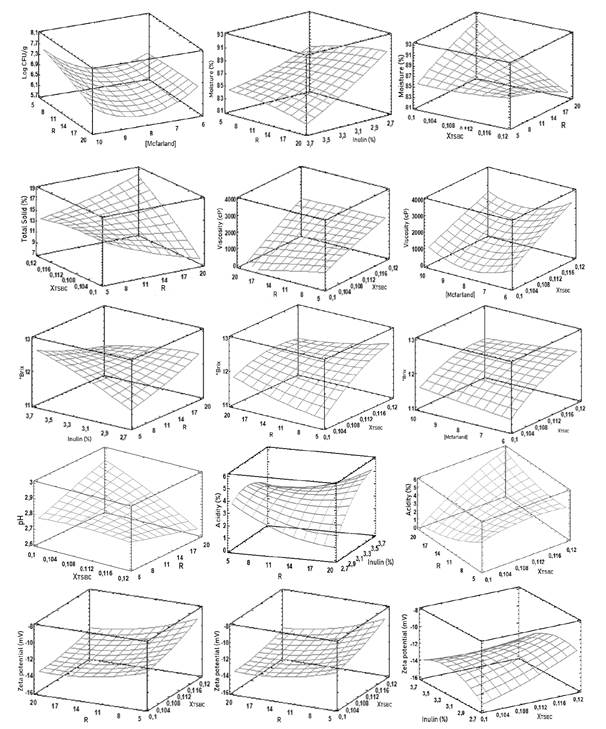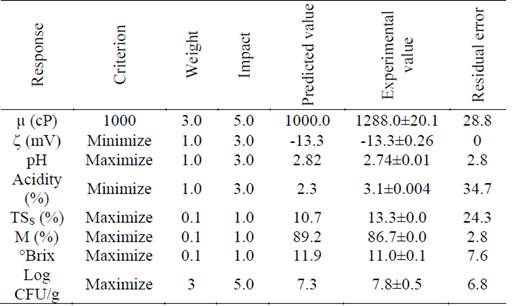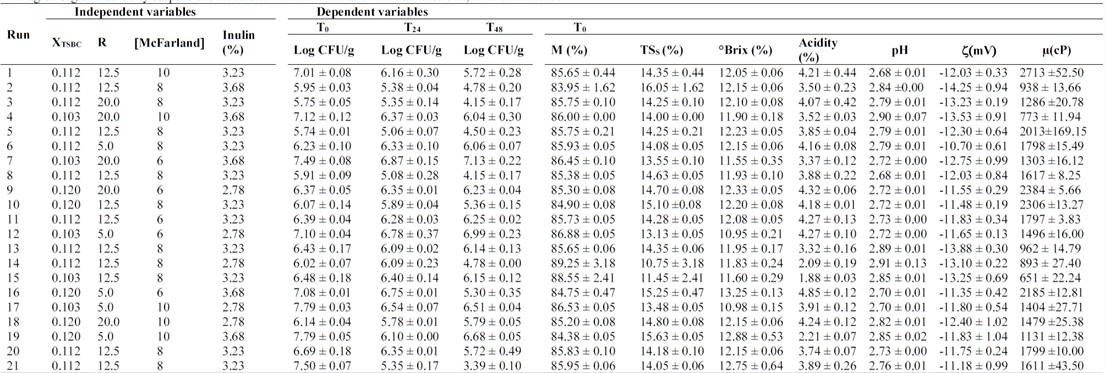1. Introduction
Blackberry (Rubus glaucus Benth) is a berry rich in phenolic components such as anthocyanins [1] and ellagitannins [2] which are related to health, the decrease of cancer cells [1,3], protection against liver damage, blood pressure reduction, anti-inflammatory and antimicrobial activities [1], among others. This fruit has a high respiratory rate, which makes it a perishable product and, therefore, it has a short postharvest life and limits its use as fresh fruit [1]; for this purpose, some research has reported technological alternatives which allow delaying respiration rate and moisture loss: hypobaric storage, protective films [4], refrigeration, traditional and rapid freezing, spray drying, modified atmospheres and irradiation [1,5]. Its flavor and functional properties make blackberry a much-desired fruit all around the world [6]. The United States is the largest exporter of blackberry in the world, followed by Spain and Mexico [7], 90% of production is converted into processed products such as nectars, juices, frozen pulps, concentrates, jams, jellies, and dehydrated powders, and the remaining 10% is destined to fresh consumption [6].
Nowadays, world market demands specific attributes on functional foods, which are those that, besides providing basic nutrients, contain components with physiological activity or active components which contribute to the prevention of some diseases [3]. In this context, one of the components most widely used in food industry is Lactobacillus casei, a gram-positive microaerophilic, auxotroph bacillus, part of the microbiota of fruits, vegetables, meat, milk, wine, intestinal and vaginal mucous, able to reach the human intestine and multiply without damaging the host [8-10]. In addition, it has a series of healthy properties: it prevents the alteration of intestinal microbiota, helps to eliminate cholesterol and reduces osteoporosis risk, among others [11]. Therefore, it is considered a probiotic microorganism widely used in the development of functional foods [12]. By regulation, a functional food with probiotic characteristics must contain a number ( 1 x 106 CFU/g or mL until the end of its useful life [9,13-15].
Literature does not report viability studies of probiotic microorganisms in blackberry- based colloidal. However, there is interest in using different dietary matrices to maintain the viability of these probiotics and thus offer the modern consumer innovative, stable and healthy products within the range of functional foods [16]. Many of these foods range from suspensions to dry products, where the guarantee of microorganism viability is essential at any stage of the process. For example, pear juice obtained levels of 107 CFU/mL of Lb. casei inoculated at 2% [17], Cape gooseberry pulp inoculating a (McFarland( of 0.5 Lb. casei ATCC 393 obtained 5.4x108 CFU/mL [18], while guava juice 8 Log CFU/mL units of encapsulated Lb. casei 431 were inoculated obtaining 7.06 Log CFU/g [19]. On the other hand, characteristics of foods can influence strains survival, so it is convenient to protect probiotics by reducing their physical exposure during the passage through the gastrointestinal tract, either through encapsulants or with the addition of prebiotics that helps them survive during the passage through the stomach [20].
The aims of this investigation was to evaluate microbial cell viability of the commercial strain Lactobacillus casei ATCC 393 and the properties in blackberry suspensions added with inulin as a prebiotic agent.
2. Materials and methods
2.1. Materials
Blackberry concentrate (BC) (Nutrium SAS) was used with specifications according to the technical data of ºBrix: 13-15%, citric acidity: 3.1-5.5, and pH: 2.5-3.5. The commercial strain was Lactobacillus casei ATCC393. It was activated in 5 mL of MRS broth (Man, Rogosa and Sharpe) (Scharlau) at 37 °C for 72 h in anaerobic conditions, and added in 200 mL of the same broth. Then, it was incubated under the same conditions to generate biomass. Finally, Fibruline S20 inulin (Cosucra, Groupe Warcoinng SA) was used as a prebiotic agent.
2.2. Preparation of the inoculum
The microorganism suspended in MRS broth was centrifuged at 2000 rpm for 10 min at 25 °C, separating the biomass used to prepare McFarland standards 6, 8 and 10 by optical density. The microorganism was diluted in sterile water and taken to spectrophotometry for reading at 625 nm [18].
2.3. Experimental design and preparation of suspensions
It was carried out using response surface methodology with a composite central design, face-centered (α = 1) with 21 experiments (Table 1), considering the independent variables: mass fraction of TS contributed by BC (XTSBC) (0.103 - 0.120), (McFarland( (6 - 10), inulin (2.78 - 3.68%), and R (5 - 20); and the dependent variables: moisture (M), pH, acidity, °Brix, TS in final suspension (TSS), viscosity (μ), zeta potential (ζ), and Log CFU/g. The valuations were made at times 0, 24 and 48 hours (T0, T24, T48). The quantities of each component were determined from material balances for batches of 250g; initially, a suspension of BC was prepared to XTSBC of design, using a Silverson homogenizer L5M-A at 10,000 rpm, then inulin and finally inoculum biomass with desired (McFarland( were added. This suspension was refrigerated at 4 °C and stored at times of 0, 24, and 48 h.
2.4. Viability of Lb. casei
It was determined by plate count of microorganisms. Initially, 10 g of suspension were homogenized with 90 mL of universal peptone (0.1% w/v) using 80 Lab Blender stomacher, then successive dilutions were made up to 106 with universal peptone in a ratio of 1:9, which were inoculated 0.1 mL in petri dishes with MRS agar by the planting on surface method; finally, they were incubated at 37 °C for 72 h under anaerobic conditions.
2.5. Characterization of suspensions
Acidity tests were performed according to AOAC method 942.15/2012 expressed as malic acid, by titration with 0.1N NaOH, and using phenolphthalein as indicator [21]; pH by AOAC method 981.12/2012 with a Schott potentiometer CG840B [21]; °Brix according to AOAC method 932.12/2012 with a Leica auto ABBE refractometer [21]; M following AOAC method 20.013/2012 with vacuum oven at 60 °C until constant weight [21]; TSs was determined by difference with M in the final suspension; μ was measured with a Brookfield viscometer DV-III Ultra at 100 rpm, RV-5 spindle at 25 °C [22]; water activity (aw) according to AOAC method 978.18/2012 with a dew point hygrometer Aqualab 4TE, Decagon Devices USA at 25 °C [21]; ζ was determined on a Zetasizer Nano ZS90 (Malvern Instruments Ltda.) using a capillary electrophoresis cell [23]; and optical density with a Thermo Scientific Evolution 60 UV/VIS spectrophotometer [24].
3. Results and analysis
The characterization of BC presented values of M: 83.97 ± 0.02% and aw: 0.990 ± 0.002, which makes it a product with characteristics suitable for the growth of beneficial microorganisms, alterants and pathogens [25]. TS values: 16.03 ± 0.02% and °Brix: 12.10 ± 0.14% (soluble in liquid fraction), which affect the osmotic pressure of food system and at the same time the viability of microorganisms of interest [26]; acidity values: 5.85 ± 0.16% and pH: 2.74 ± 0.00, which frames it within acidic foods; ζ values : -11.17 ± 0.60 mV which identifies BC as a colloidal system with repulsive electric forces of negative charge in the proximity of coions layer, formed around the interphase of the suspended particles [27] and for this case, negative ions obtained from the dissociation of salts present in BC [28]. Blackberry pulp has been identified as a non-Newtonian, pseudoplastic liquid [29]; while, BC is a much more viscous product (μ: 5093.3 ± 201.7 cP), which could affect the mobility of suspended particles, contributing to the colloidal system stability.
Some authors have reported different results in food matrices based in blackberry: [28] in BC (citric acidity: 1.67%, pH: 2.89 and °Brix: 65.0%), and in blackberry pulp (citric acidity: 1.65%, pH: 2.86 and °Brix: 8.9%); [1] in blackberry pulp (citric acidity: 0.76%, pH: 3.31, °Brix: 6.77% and M: 91.96%); [30] in blackberry pulp (citric acidity: 1.88%, pH: 3.03, Brix: 9.06, M: 83.5% and aw: 0.984) and finally, [31] in blackberry pulp (pH: 3.24; Brix: 8.5%, M: 87.7% and aw: 0.981). A variability is observed when compared with the results obtained in BC of the present investigation, which is attributable on the one hand to production conditions and concentration levels of BC; on the other hand, the differences between pulps for the same variety of fruit, which is affected by other pre-harvest factors: climatic, solar radiation, soil, rain, among others [32], and post-harvest factors such as maintenance of the cold chain [33].
Table 1 shows the mean values and standard deviation of Log CFU/g of blackberry inoculated with Lb. casei and inulin suspensions evaluated at times 0, 24, and 48 h (T0, T24, T48) and the physical and physicochemical properties of suspensions at T0. A very definite tendency is observed in suspensions, where Log CFU/g units decrease with storage time; therefore, T0 was selected for its highest content of probiotic microorganisms. This situation is attributable to different factors, on the one hand, the effect of osmotic, thermal and oxidative stress on Lactobacillus cell wall; on the other hand, to the effect of the pH of BC itself. The pH has an effect on growth and viability of microbial cells, because intracellular pH of bacteria remains close to neutrality and the decrease of extracellular pH can lead to the destruction of cellular macromolecules, since these are sensitive to acids, especially weak acids that enter cells and dissociate (H+) in the cytoplasm, decreasing the ability of cells to generate energy [34]. A sudden increase in external osmolarity results in the elimination of water from the cell to the outside, producing loss of turgor, as well as changes in intracellular solute concentration and cell volume, decreasing metabolic activity and therefore lower viability [35]. These types of stress, by subjecting the microorganism to a prolonged exposure over time can lead cells to microbial death; however, if microorganisms are subjected to an acid stress with pH<4.5 in short times, heat shock proteins can be produced in the microorganism, helping them to generate resistance to heat stress [36].
Fig. 1 shows response surface graphs of dependent variables with respect to independent variables; while Table 2 presents the ANOVA that identifies dependent variables showing significant differences (p <0.05) with respect to independent variables, with linear and quadratic interactions. The average values obtained from plate count varied between 5.74 and 7.79 Log CFU/g, equivalent to 5.5 x 105 and 6.2 x 107 CFU/g, which indicates that some values do not meet the minimum required by Colombian and international regulations (106 CFU/g) [12, 37].

Source: The Authors.
Figure 1. Response surface graph of BC suspensions inoculated with Lb. casei and inulin for a time of 0 hours (T0).
Table 2. ANOVA of blackberry suspensions inoculated with Lb. casei and inulin to T0.

Source: The Authors.
The behavior of Log CFU increases mainly when (McFarland( is higher than 9, being enhanced when R is minimum (R = 5) and (McFarland( = 10, where logarithmic units per gram reached their highest values: 7.79 ± 0.03 (inulin: 2.78% and XTSBC: 0.103) and 7.79 ± 0.05 (inulin: 3.68% and XTSBC: 0.120). This situation is attributed to the fact that inoculation is done at the highest microbial concentration and with the highest mass of inoculum, which results in a good microorganism recovery.
Some authors have investigated the viability of different microorganisms in various food matrices and prebiotic agents: in yogurt and orange juice complemented with inulin and galacto-oligosaccharides (GOS). Lb. acidophilus and Lb. casei 01 were evaluated during storage at 4ºC for 4 weeks, increasing probiotic protection and growth as a result of implementing GOS (1.5%) (>107 CFU/g or mL) compared to a control without GOS; obtaining counts for yogurt above control in logarithmic units of 1.1 and 0.4 for Lb. acidophilus and Lb. casei 01 respectively [38].
On the other hand, in cape gooseberry pulp and in glucose solution, Lb. plantarum and Lb. casei ATCC 393 were inoculated, reporting counts at 15 days and 4 °C of Lb. plantarum of 3.23 x 109 and 1.64 x 109 CFU/mL respectively; while Lb. casei ATCC 393 obtained counts 5.4 x 108 and 7.34 x 108 respectively [18]; and in mango, lulo and strawberry juices inoculating 1010 CFU/mL of Lb. plantarum, a viability of 108 CFU/mL was reported after 30 days of storage at 8 °C [39].
Average values of M fluctuated between 83.95% and 89.25%, and for TSS between 10.75% and 16.05%, observing coherence between them. M was higher when the suspension formulation showed lower XTSBC, higher R and lower inulin contents, and TSs levels decreased under these compositions. On the other hand, these parameters are also related to the µ of suspension, which is a relevant property in spray drying processes and which average values were between 651 and 2713 cP. An important relationship of µ with XTSBC was evident, getting higher when it increases, which is consistent due to higher content of TSS
The effect of [McFarland] became more relevant to the scale of 8, where µ decreases to higher XTSBC; whereas, the influence of R is more noticeable when suspension has µ<1000 cP, which increases as R decreases (< presence of BC) and XTSBC is smaller. These interactions influence the rheological response of suspension and at the same time in microbial population, due to the effect of TSS on the medium’s osmotic pressure, which causes cell plasmolysis, resulting in possible inhibition of microorganisms and therefore in its viability [35,40].
There isn’t much literature regarding the rheological properties of blackberry suspensions, seen from the pulp itself to concentrates. Blackberry pulp is reported for viscosity values of 2061.8 cP and enzymatically treated 150 cP [41].
Average °Brix suspension values fluctuated between 10.95% and 13.25%, which are available for strain maintenance. A decrease was observed, mainly at lower XTSBC, improving when it interacts at low values of R and [McFarland], which is consistent due to the greater mass of inoculum (>water content) and lower content of microorganism in the inoculum. On the other hand, there is an important effect of inulin-R interaction, which occurs at low values of R and inulin, attributed to an effect similar to that previously mentioned. Literature does not report values of soluble solids in blackberry suspensions inoculated with microorganisms, they are reported mainly in fruit with significant variability, due to maturity degree, climatology, soils, solar radiation, among others [32]; 7.74% with degree of maturity of 5 [42], 12.07 and 13.53% [43]. On the other hand, other authors report values in blackberry pulp of 6.77% [1] and in soft drinks 9.54% and 10.53% [44].
Average pH values fluctuated between 2.7 - 2.9, which indicates that there is no marked influence of independent variables considered on this variable. Blackberry and blackberry products are known to have an acidic pH, literature shows values between 2.65 and 2.93 [43,45] for fruit, and values of 3.31 [1] for pulp. Acidity results fluctuated in a higher proportion than that of pH: 1.9% and 4.8%, with a noticeable increase as R and [McFarland] decrease, along with an increase of XTSBC and inulin. However, major changes (> acidity) happen at high R values and their interactions with XTSBC and inulin, which is attributed to a higher content of BC (malic acid: 5.85%) and inulin, with little inoculum mass (> water content), which favors acid concentration in suspension. For Andean blackberry, reported values of acidity fluctuate: 3.66% [42], 2.30% [43] and 2.83% [45] and 2.62-2.74%; while, for blackberry pulp a value of 0.76% is reported and expressed as citric acid. Literary sources do not mention growth for blackberry-based substrates, some work is highlighted in cashew juice where a greater viability of Lb. casei at pH of 6.4 was obtained [46]; on the other hand, Lb. plantarum survival of 68.7% at pH 2.0, inoculated in fruit juices was reported [39].
ζ values showed low fluctuation: -14.25 and -10.70 mV, which denotes a negative predominant electric charge in the outer coion layers, which contributes to low repulsive forces in the colloidal system (ζ |> 25 mV). However, there is an alleged synergy with suspension viscosity that makes it stable, since no separation phase or precipitates were seen with time [47]. ζ is favored mainly by the effect of R-XTSBC interactions, with repulsive forces being greater (ζ more negative) when the colloidal system has a higher concentration of BC and with higher R (more BC and less water), which causes a higher amount of anions adsorbed in coion layers. Inulin and inoculum represent another important aspect affecting the colloidal system stability, which individually reached values of -5.18 and -3.46 mV respectively.
Model optimization and validation: optimization parameters of BC suspension inoculated with Lb. casei and inulin, were determined under the criteria of promoting microorganism viability and compliance with design criteria operability of pilot Vibrasec PSALAB1.5 spray dryer (µ≈ 1000 cP and TS ≤ 45%). Weights and impacts considered and optimization results are listed in Table 3.
Table 3. Results of experimental optimization of BC suspension inoculated with Lb. casei and inulin.

Source: The Authors.
Multiple optimization results showed a desirability of 69.1%, defining suspension independent variables or formulation as follows: XTSBC: 0.103, R: 15.6, McFarland Scale: 10% inulin: 3.1%. Most dependent variables showed an acceptable residual error between the predicted value of mathematical model and the experimental value obtained from 3 replicas of this formulation. The ones displaying a greater residual errors are attributed because the response surface generates trends that are expected to coincide with experimental values.
4. Conclusions
Lb. casei ATCC 393 probiotic microorganism showed an adaptability in BC based and inulin suspensions, which guarantee its viability. The independent variables that are believed to affect microorganism viability the most are BC, the amount of inoculum and (McFarland(. Counts obtained from microorganism could identify colloidal suspension as a functional food with probiotic characteristics. For an effective use of suspension in a spray drying process, an inoculation time of 0 hours was considered adequate, since microorganism viability decreases with time and the effect of prebiotic was not evident.















